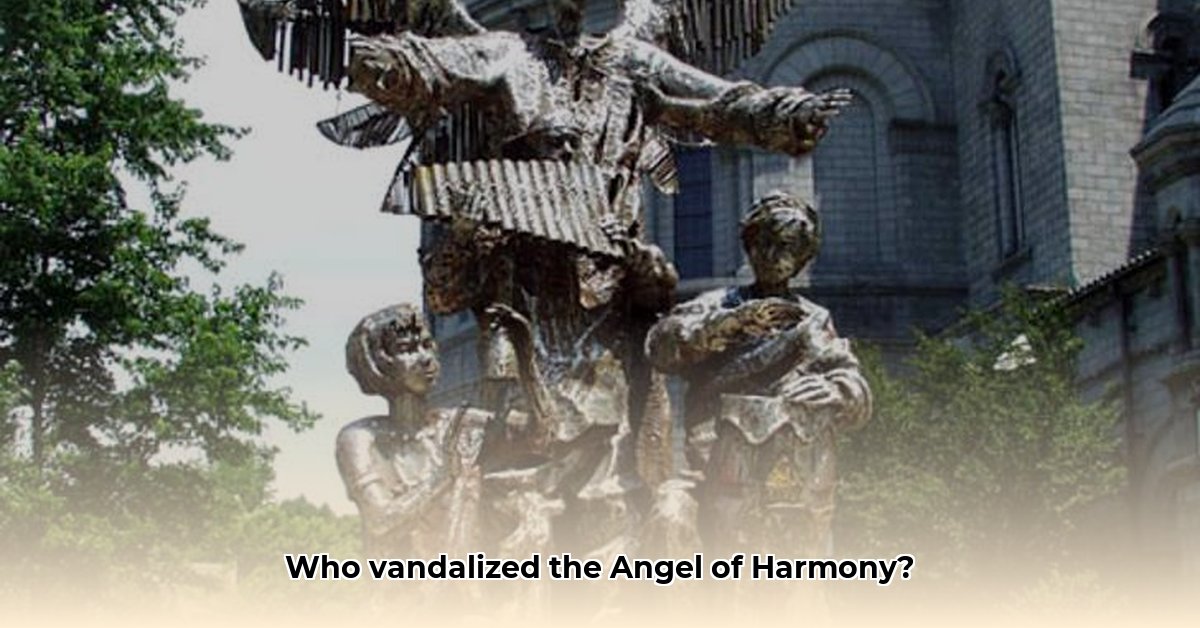Statue Attacked: Symbol of Harmony Damaged
On Sunday, September 17, 2024, the “Angel of Harmony” statue outside the Cathedral Basilica of St. Louis was vandalized. Police arrested 35-year-old Christopher Jaros, who allegedly used a boom lift to tear the statue from its base. The incident has shocked the community and sparked discussions about the statue’s significance and its future.
Artist’s Vision: A Legacy Disrupted
The 14-foot stainless steel statue, created by Polish-American artist Wiktor Szostalo in 1999, depicts a Black angel with outstretched wings adorned with wind chimes, embracing children of diverse backgrounds playing musical instruments. The base, crafted from black African granite, bears inscriptions of peace from the Bible, Dr. Martin Luther King Jr., and Pope John Paul II. The statue, a gift from Adelaide Schlafly in memory of her husband Daniel, symbolizes unity, racial harmony, and peace. Szostalo, a former Solidarity Movement activist, imbues his work with a powerful message of hope and reconciliation.
Vandalism Details: Charges and Damage Assessment
Jaros faces multiple charges, including two counts of first-degree property damage, first-degree tampering, unlawful use of a weapon, resisting arrest, and institutional vandalism. He is being held without bond. While the motive remains under investigation, authorities suggest a possible mental health episode may have been involved. The statue sustained extensive damage, including a broken section on one of the children and damage to the angel’s wings and wind chimes.
Restoration and Community Response: Rebuilding Harmony
Archbishop Mitchell Rozanski has expressed hope for the statue’s full restoration. Szostalo, the original artist, has taken on the task, meticulously repairing the damaged sections. The restoration is expected to be completed by Spring 2025. The community has responded with outrage at the vandalism and support for the restoration efforts. The incident has spurred discussions about protecting public art and reinforcing community values.
| Aspect | Details |
|---|---|
| Date | September 17, 2024 |
| Suspect | Christopher Jaros, 35 |
| Charges | Property damage, tampering, unlawful use of a weapon, resisting arrest, etc. |
| Artist | Wiktor Szostalo |
| Restoration | Underway, expected completion Spring 2025 |
| Community Response | Outrage, support for restoration, discussions about public art protection |
The Symbolism and Significance: More Than Just Metal
The Angel of Harmony represents more than just artistic expression; it embodies the community’s aspirations for peace and understanding. Its vandalism is not merely an attack on an object but a symbolic attack on the values it represents. The statue’s placement at the Cathedral Basilica further emphasizes its spiritual and moral significance. The inscriptions at its base amplify its message of love, acceptance, and the pursuit of a more harmonious society.
Looking Ahead: Lessons and Hope
The vandalism of the Angel of Harmony serves as a stark reminder of the fragility of peace and the ongoing need for dialogue and understanding. While the incident is undoubtedly tragic, it has also galvanized the community. The restoration efforts, led by the original artist, offer a symbol of hope and resilience. The incident also highlights the importance of balancing public accessibility to art with measures to ensure its protection. While increased security might be considered, fostering a community that respects and values public art is crucial. The Angel of Harmony’s return will not only mark the restoration of a beloved artwork but also reaffirm the community’s commitment to the values it embodies.
This incident raises questions about how we protect public art and the motivations behind such acts of vandalism. Some speculate that the targeting of a symbol of racial harmony may suggest a bias-motivated crime. Others caution against premature conclusions, emphasizing the need to await the results of the ongoing investigation. There is ongoing debate about the role of mental health in such incidents and the appropriate response from the justice system.
The community’s response underscores the statue’s importance. While the physical damage can be repaired, the emotional impact on the community will likely take longer to heal. This incident serves as a catalyst for conversations about tolerance, respect, and the importance of preserving our shared cultural heritage. It also highlights the potential for art to inspire healing and reconciliation.
- Grass Forever in Livermore: Your Guide to Artificial Turf - April 22, 2025
- German Roaches vs. American Roaches: Key Differences and Control - April 22, 2025
- 150+ Flowers That Start With S: A Comprehensive Guide - April 22, 2025










